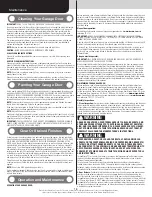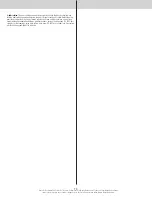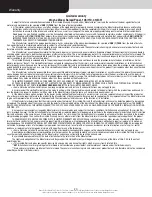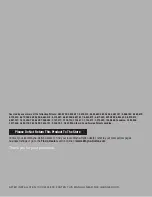
Please Do Not Return This Product To The Store. Contact your local Wayne-Dalton dealer. To find your local Wayne-Dalton dealer,
refer to your local yellow pages business listings or go to the Find a Dealer section online at www.Wayne-Dalton.com
1a. Center
bearing bracket
Torsion shaft
or
Torsion keyed shaft
1b. Center
bearing
Black cable drum
(left hand side)
Red cable drum
(right hand side)
Left hand wound,
black winding cone
(left hand side)
Right hand wound,
red winding cone
(right hand side)
1c. Oval
bearing
Center
bracket
One or Two springs, One piece shaft
NOTE:
Center brackets and
bearings may vary from those
shown.
2.
Lay the torsion spring with the red winding cone at the left end of the torsion shaft/torsion
keyed shaft. Next, lay the torsion spring with the black winding cone at the left end of the
torsion shaft/torsion keyed shaft. Lay the torsion spring with the black winding cone at the
right end of the torsion shaft/torsion keyed shaft. Next, lay the torsion spring with the red
winding cone at the right end of the torsion shaft/torsion keyed shaft. Next, lay the center
bearing bracket, the center bearing or the oval bearing at the center of the torsion shaft/
torsion keyed shaft.
Torsion shaft
or
Torsion keyed
shaft
Black cable drum
(left hand side)
Red cable drum
(right hand side)
Right hand wound,
red winding cone
(right hand side)
Left hand wound,
black winding cone
(left hand side)
Right hand wound, red winding
cone (right hand side)
Left hand wound,
black winding cone
(left hand side)
1a. Center
bearing
bracket
1b. Center
bearing
1c. Oval
bearing
Center
bracket
Two or Four springs, One piece shaft
NOTE:
Center brackets and bearings
may vary from those shown.
3.
Starting on the left hand torsion keyed shaft, lay the torsion spring with the red winding
cone at the right end of the torsion keyed shaft. Next, lay the torsion spring with the black
winding cone at the left end of the torsion keyed shaft. Next, starting on the right hand
torsion keyed shaft, lay the torsion spring with the black winding cone at the left end of the
torsion keyed shaft. Next, lay the torsion spring with the red winding cone at the right end of
the torsion keyed shaft. Next, lay either the center bearings or the oval bearings in between
the two torsion keyed shafts.
Torsion
keyed
shaft
Black cable drum
(left hand side)
Red cable drum
(right hand side)
Right hand wound,
red winding cone
(right hand side)
Left hand wound,
black winding cone
(left hand side)
Right hand wound,
red winding cone
(right hand side)
Left hand wound,
black winding cone
(left hand side)
Coupler
halves
Torsion keyed shaft
1a. Center
bearing
1b. Oval
bearings
1a. Center
bearing
Center
bracket
Two or Four springs, Two piece shafts
NOTE:
Center brackets and bearings
may vary from those shown.
Disassemble the coupler assembly by removing the hex head screws, the lock washers,
the flat washers and the hex nuts from the coupler halves. Loosen the set screws. Set the
components aside. Next, slide the flat edge of the couple half flush with the side edge of the
torsion keyed shaft. Insert (1) keyed shaft into the slot of both the coupler half and the slot in
the torsion keyed shaft, as shown. Tighten the (2) set screws and the locking nut to secure
the coupler half to the torsion keyed shaft.
NOTE:
Tighten the set screws to 14-15 ft. lbs. of torque (once set screws contact the shaft,
tighten set screws one full turn).
Repeat the same process for the other side.
Torsion
keyed
shaft
Coupler
halves
Coupler
half
(3) Hex head
screws
(4) Set screws and
(2) Lock nuts
Torsion
keyed
shaft
Key
Key
(3) Lock
washers
(6) Flat
washers
(3) Hex nuts
Coupler
half
Slide either the center bearing bracket or the center bearing(s) or the oval bearing(s) onto the
torsion shaft/torsion keyed shaft(s) followed by the torsion spring(s).
IMPORTANT:
THE CENTER BEARING BRACKET, THE CENTER BEARING(S), THE OVAL
BEARING(S), THE COuPLER HALF’S AND THE TORSION SPRINGS, MuST BE POSITIONED, AS
SHOWN.
WARNING
WARNING
CENTER BEARING BRACkETS WITH SPRINGS MuST BE SECuRELy FAS-
TENED INTO SOLID STRuCTuRAL MEMBERS ONLy AND MuST BE AD-
EquATELy REINFORCED TO HOLD THE LOAD OF TORSION SPRING ASSEM-
BLIES. FAILuRE TO DO SO CAN CAuSE SEvERE OR FATAL INJuRy.
If you have a Torsion Shaft or a Torsion Keyed Shaft:
With assistance, pick up the torsion spring assembly and slide one end of the shaft through
the end bearing bracket. Extend the shaft through the bearing until the opposite end of the
shaft can be inserted into the other end bearing bracket. Secure the center bearing bracket
to the ceiling using perforated angle (refer to Step Rear Back Hangs) or wood blocking (ad-
equate framing member(s)). Lay the middle of the shaft into the center bracket (if applicable).
Torsion shaft
or Torsion
keyed shaft
Horizontal
track
End
bearing
bracket
Center bearing
bracket
End
bearing
bracket
Torsion shaft or
Torsion keyed shaft
Horizontal
track
End
bearing
bracket
Center
bracket
End
bearing
bracket
Center
bracket
Center
bearing
Oval
bearing
Center
bearing
Center
bearing
If you have two Torsion Keyed Shafts:
With assistance, pick up the left hand torsion spring assembly and slide one end of the
torsion keyed shaft through the end bearing bracket and secure the center bearing bracket
to the ceiling using perforated angle (refer to Step Rear Back Hangs) or wood blocking
(adequate framing member(s)). Lay the inner most part of the shaft into the center bracket (if
applicable).
Secure center bearing bracket(s) to adequate framing member at the center of torsion shaft
using (3) 5/16” x 2” lag screws.
NOTE:
If your door came with a coupler assembly, the (2) center bearing brackets will need
to be spaced 12” to 14” apart, at the center of the door.
IMPORTANT:
uSE A 5/16” x 1-5/8” TAMPER-RESISTANT LAG SCREW INSTEAD OF THE
5/16” x 2” TAMPER-RESISTANT LAG SCREW IF MOuNTING SuRFACE IS MOuNTED OVER
MASONRY. TAMPER-RESISTANT LAG SCREW MuST BE ATTACHED THROuGH THE BOTTOM
HOLE OF THE CENTER BEARING BRACKET.
Repeat the same process for the right hand torsion spring assembly.
13
Summary of Contents for 105/110
Page 21: ......






















